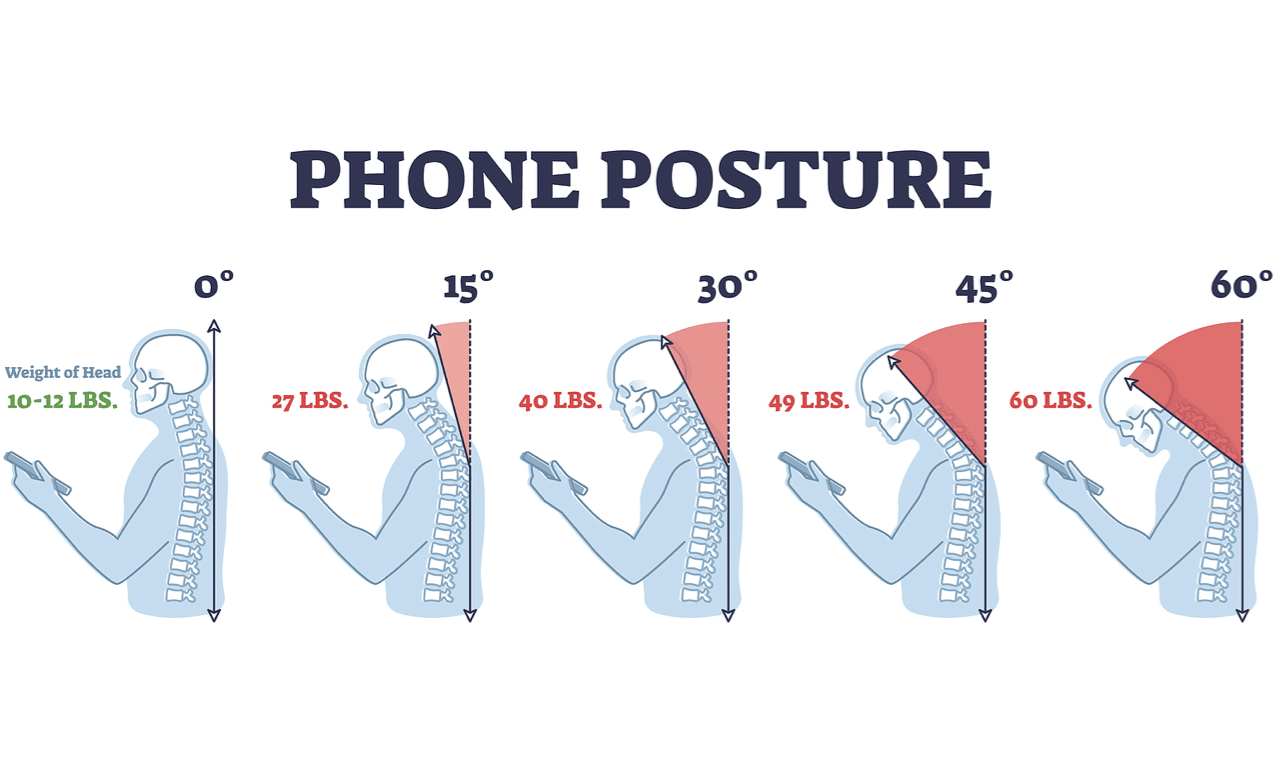The Modern-Day Ache You Can’t Ignore
In our digitally-driven world, the constant use of smartphones, tablets, and computers has given rise to a pervasive health concern: “text neck.” Also known as “tech neck” or “smartphone neck” , this repetitive stress injury stems from prolonged periods of looking down at electronic devices.
The prevalence of neck pain, often linked to these digital habits, has escalated dramatically, becoming the fourth leading cause of disability globally. Alarmingly, nearly 50% of those affected experience chronic or frequent recurrences of discomfort. This widespread issue has led health experts to label text neck and forward head posture as a “global epidemic” and a significant “worldwide public health problem”. Globally, 50–84% of smartphone users report neck symptoms, with some studies estimating up to 93% in heavy users. Furthermore, nearly 70% of students using phones for 5 hours or more per day experienced neck problems. This underscores the urgent need for greater awareness and effective strategies, especially since public understanding of text neck syndrome remains low.
Understanding “Text Neck”: More Than Just a Pain in the Neck
“Text neck” is a widely recognized term, coined by chiropractor Dr. Dean L. Fishman, to describe the strain and stiffness in the cervical spine caused by prolonged, repetitive head flexion while using electronic devices. This posture often leads to a visible “hunchback” appearance (kyphosis) and rounded shoulders.
The Physics of Your Posture: Why Your Head Feels So Heavy
The mechanics behind text neck are rooted in simple physics. The average human head weighs approximately 10 to 12 pounds in a neutral, upright position. However, as the head tilts forward, the strain on the neck muscles and spine increases dramatically, making the head feel significantly heavier.
Consider the following breakdown of how head tilt amplifies the force exerted on the cervical spine:

| Degrees of Head Tilt | Approximate Force on Neck (lbs) |
| 0° (Neutral) | 10-12 |
| 15° | 27 |
| 30° | 40 |
| 45° | 49 |
| 60° | 60 |
Data compiled from various sources.
To put this into perspective, tilting the head forward by just 60 degrees can place a staggering 60 pounds of pressure on the neck. This is equivalent to carrying an 8-year-old child or a Golden Retriever on the neck for hours each day. This constant, excessive load is a persistent, cumulative strain that leads to gradual wear and tear.
Who’s At Risk? The Alarming Prevalence
Text neck affects all demographics, with a particular concern for younger populations. Children and adolescents are especially vulnerable due to their widespread device ownership and usage patterns. Their developing bodies, larger head-to-body ratio, and smaller muscle fibers mean their neck extensors work harder, leading to quicker fatigue that often goes unnoticed. Documented cases show excessive phone use leading to curvature changes and serious postural issues in children as young as seven.
Research highlights the alarming prevalence across various groups:
- Students and Remote Workers: A significant 73% of university students and 64.7% of individuals working from home report neck and back pain linked to text neck. Studies indicate a high prevalence of neck pain among mobile device users, ranging from 17.3% to 67.8%.
- Smartphone Overuse: A meta-analysis confirms a significantly higher risk of neck pain for smartphone overusers, with a pooled adjusted odds ratio of 2.34.
- Usage Duration: Studies show a strong correlation between smartphone usage duration and neck problems. For instance, 69.9% of students using phones for 5 hours or more per day, and 77% of those using them for 4-5 hours daily, experienced neck problems. On average, adults spend 3 hours and 15 minutes on their phones daily, checking them approximately 58 times.
- Lifestyle Factors: Individuals engaged in “non-practical” studies (implying less physical activity) exhibit higher text neck prevalence compared to “practical” students. This indicates that a more sedentary lifestyle exacerbates the risk.
A key behavioral factor is the tendency for visual comfort to override postural comfort. Individuals often adjust their posture for the best screen view, even if it compromises spinal alignment.
Recognizing the Signs: Symptoms and Long-Term Consequences
The effects of text neck extend beyond immediate discomfort, manifesting in a range of symptoms and potentially leading to severe, long-term health complications if left unaddressed.
Common Symptoms to Watch For
Recognizing early signs is crucial. Common symptoms include:
- Neck Pain: Persistent or intermittent pain, ranging from mild to debilitating.
- Upper Back Pain: Aching or discomfort, sometimes escalating to sharp muscle spasms.
- Shoulder Pain and Tightness: Strain on shoulder muscles leading to tension and discomfort.
- Headaches: Tension or cervicogenic headaches.
- Reduced Range of Motion: Difficulty turning head or looking up.
- Muscle Stiffness and Tightness: Common in neck and upper back muscles.
- Changes in Posture: Noticeable forward head posture and rounded shoulders.
- Increased Pain with Neck Flexion: Symptoms worsen when neck is flexed forward.
The Ripple Effect: Beyond Immediate Discomfort
The consequences of text neck can impact the entire musculoskeletal system and vital bodily functions.
- Muscle Imbalances & Endurance: Prolonged poor posture leads to specific muscle imbalances. Deep cervical flexor muscles become elongated and weakened, while posterior neck and chest muscles shorten and tighten. This deconditioning, along with reduced endurance in neck flexors/extensors, is strongly linked to neck pain in heavy users.
- Spinal Misalignment and Degeneration: Constant strain can alter the natural spinal curvature, potentially leading to cervical kyphosis (reversal of the neck’s natural curve). This accelerates wear and tear of intervertebral discs, contributing to degenerative disc disease, herniated, or bulging discs.
- Nerve Compression: Increased pressure on the cervical spine can compress nerves, leading to radiculopathy (a pinched nerve), manifesting as pain, tingling, numbness, or weakness radiating into the arms and hands.
- Jaw Pain (TMJ): Altered neck muscles and spinal pressure can strain the jaw joints and muscles, causing temporomandibular joint (TMJ) pain.
- Hand/Wrist Strain: Excessive phone use can also lead to “text claw” or “trigger thumb,” causing discomfort in the hands and wrists.
- Balance Issues: Prolonged forward head posture has been linked to reduced balance control and weakened proprioceptive system of the cervical spine.
- Broader Systemic Impacts: Chronic poor posture can negatively affect vital bodily functions, leading to shortness of breath and respiratory dysfunction by compressing internal organs and impeding lung function. It can also reduce peristaltic function, impacting digestion.
- Chronic Pain and Disability: If left untreated, text neck can evolve into chronic pain, significantly impairing daily life and quality of life. Neck pain is a leading cause of disability.
- Early Onset Arthritis: Increased and uneven pressure on the cervical spine can accelerate the development of arthritis in the neck.
- Potential for Increased Mortality: In its most severe form, pronounced hyperkyphosis has been linked to higher mortality rates in older individuals, with studies showing a 44% greater mortality rate.
The economic impact of musculoskeletal disorders, including text neck, is substantial, estimated at over $380 billion in 2016, surpassing diabetes, cardiovascular disease, and cancer. Despite this immense burden, research into neck pain receives disproportionately low funding, less than 1% of predicted research dollars.
Your Action Plan: Smart Strategies for Prevention & Relief
Addressing text neck requires a multi-faceted approach combining conscious postural adjustments, ergonomic modifications, and regular physical activity. The good news is that text neck can often be reversed with proper treatment, posture correction, and muscle strengthening.
Master Your Posture: The Core Principle
The fundamental strategy is to maintain a “neutral posture”. In this ideal alignment, the head is directly over the shoulders and hips, the back is straight, and the neck is relaxed.
To achieve and maintain this alignment, consider these practical cues:
- Imagine Upward Pull: Visualize a string gently pulling the top of your head upward.
- Ear-Shoulder Alignment: Strive to keep your ears directly in line with your shoulders.
- Relaxed, Back Shoulders: Ensure shoulders are relaxed and pulled back. Create slight tension between shoulder blades to open the chest.
- Gentle Chin Tuck: Perform a slight chin tuck to align your head with your spine without tilting it down.
- Core Engagement: Actively engage your core muscles for foundational support.
Ergonomics in Action: Adjusting Your Device Habits
Small, consistent changes in how devices are used can significantly reduce strain.
- Raise Your Gaze:
- Hold your phone or tablet closer to eye level. If below eye level, look down with your eyes, not by bending your neck.
- Utilize phone or tablet stands, or improvise with pillows or books, to elevate devices.
- Take Frequent Breaks:
- Aim for a pause every 5-15 minutes of smartphone use.
- During breaks, stand up, stretch, or walk to reset posture.
- Set alarms or use apps for reminders.
- Implement the “20-20-20 rule” for eye breaks.
- Go Hands-Free:
- For long conversations, use a speakerphone or Bluetooth headset.
- For text-heavy tasks, consider voice recognition software. Using a laptop or desktop is often more efficient for long texts.
- Optimize Your Workspace (for computers/laptops):
- Position monitor so the top is at or slightly below eye level, allowing for a natural 15-degree downward eye gaze. Maintain 20-40 inches distance.
- Invest in an ergonomic chair with proper lumbar and neck support. Ensure feet are flat on the floor or supported, and knees are at a 90-degree angle, level with or slightly below hips.
- Position keyboard and mouse so elbows are bent at 90-120 degrees and wrists remain straight.
- Avoid using devices while walking, as this increases spinal pressure.
- Refrain from looking at your phone in bed, as it’s a problematic position.
Tech Tools to Support Your Spine
Technology can also be part of the solution.
- Posture Correction Apps: Applications like “Text Neck App” and “Hunched” offer real-time posture feedback through visual cues, vibrations, or beeps, helping to build consistent healthy habits.
- Ergonomic Accessories: Phone and tablet stands , laptop stands , and monitor arms can elevate screens. External keyboards allow for proper screen positioning with comfortable typing.
The following checklist provides a concise summary of daily actionable tips to prevent and alleviate text neck:
Quick Fixes for Tech Neck: A Daily Checklist
| Category | Actionable Tips |
| Device Use | Raise phone/tablet to eye level ; Use a headset or speakerphone for calls ; Utilize phone/tablet stands for prolonged viewing ; Consider voice recognition for long texts. |
| Posture & Breaks | Maintain a neutral spine (ears over shoulders) ; Take frequent breaks (e.g., every 5-15 minutes) ; Stand up, stretch, and move regularly ; Optimize your workstation ergonomics. |
| Movement & Support | Perform daily neck stretches (e.g., chin tucks, side tilts) ; Incorporate strengthening exercises for neck and upper back ; Utilize posture correction apps for reminders. |
Simple Moves, Big Impact: Essential Exercises & Stretches
Regular stretching and strengthening are paramount for restoring muscle balance, improving flexibility, and alleviating discomfort associated with text neck. These exercises directly target the muscle imbalances that develop, such as the elongation of deep cervical flexors and shortening of posterior neck and chest muscles.
Daily Stretches for Instant Relief
Incorporate these stretches into your daily routine, ideally one to three times a day, to counteract the effects of prolonged forward head posture:
- Chin Tucks: Gently pull your chin straight backward, as if making a “double chin,” ensuring your head aligns over your spine. Hold for 5-10 seconds, then relax. Repeat 10-20 times.
- Shoulder Blade Squeezes: Sit or stand with good posture. Draw your shoulders back and squeeze your shoulder blades together. Hold for 5-10 seconds, then relax. Repeat 3-20 times.
- Neck Rotations: Facing straight ahead with shoulders relaxed, slowly turn your head to one side as far as comfortable. Hold for 15-30 seconds, then return to center and repeat on the other side.
- Side Tilts (Ear to Shoulder): Gently tilt your head, bringing your ear towards your shoulder. Hold for 15-30 seconds. Repeat on the other side.
- Upper Trapezius Stretch: Place one hand on top of your head. Gently pull your head to the side, feeling a stretch along the opposite side of your neck. Hold for 30 seconds. Complete 3-5 repetitions on each side.
- Pectoralis Stretch (Doorway Stretch): Stand in a doorway with arms on the door frame at shoulder height. Gently lean forward until you feel a stretch in your chest and shoulders. Hold for 20-30 seconds. Repeat 2-3 times.
Strengthening for Lasting Support
Strengthening the muscles that support your neck and upper back is vital for long-term relief and postural correction.
- Wall Angels: Stand against a wall with head, neck, and back in contact. Bend elbows to 90 degrees and slide arms up and down the wall, maintaining contact. Repeat 15-20 times.
- Thoracic Extension: Sit in a chair with a backrest at shoulder blade level. Place hands behind head or cross over chest. As you exhale, extend your upper spine and lean back over the chair. Hold for 5-10 seconds. Repeat 15-20 times.
- Rowing Motions: Perform rowing motions (machine, resistance band, or lying on ground) to strengthen the scapula and support the spine.
- Holistic Practices: Regularly engaging in exercises that teach posture and body awareness, such as Yoga, Pilates, and Alexander Technique, can significantly counteract poor posture.
- Self-Care for Relief: Apply ice to the affected area for the first 48-72 hours, then switch to heat therapy. Over-the-counter pain medication can help manage discomfort. Massage can also provide significant relief from muscle tension.
When to Seek Professional Guidance
While many instances of neck pain related to text neck can be managed with self-care and ergonomic adjustments, it is crucial to recognize when professional medical attention is necessary.
Seek immediate medical care if neck pain is:
- Severe or Continuous and Persistent: Pain that does not subside with rest or self-care.
- Radiating Pain: Pain that travels down the arms or legs. This could be a sign of nerve compression.
- Numbness, Tingling, or Weakness: Any sensation of numbness, tingling, or weakness in the arms or legs.
- Following an Injury: Neck pain after a motor vehicle accident, diving accident, or fall.
- Accompanied by Other Troubling Symptoms: Including severe headaches, fever, nausea, unintended weight loss, dizziness, or difficulty with fine motor skills.
For persistent or worsening symptoms, consulting a physical therapist, chiropractor, or pain specialist is highly recommended. These professionals can assess the condition, provide a tailored treatment plan, and offer targeted interventions such as manual therapy, postural retraining, and corrective exercises.
Reclaiming Comfort in a Digital World
Text neck, a modern ailment stemming from our pervasive use of digital devices, is a significant public health challenge with far-reaching implications. The cumulative strain from prolonged forward head posture can lead to chronic pain, debilitating muscle imbalances, spinal degeneration, and even impact vital systemic functions like respiration and digestion. The alarming prevalence, particularly among young adults, and the potential for severe long-term consequences, including early onset arthritis and a link to increased mortality in older age, underscore the urgency of addressing this issue.
Fortunately, text neck is largely preventable and often reversible through conscious effort and consistent application of ergonomic principles and targeted exercises. By understanding the biomechanics of how head tilt amplifies strain, individuals can empower themselves to make informed choices. The key lies in mastering neutral posture, adjusting device habits to bring screens to eye level, taking frequent and dynamic breaks, and incorporating specific stretches and strengthening exercises into daily routines. Leveraging technology, such as posture correction apps and ergonomic accessories, can also provide valuable support in maintaining awareness and consistency.
Ultimately, navigating our digital world without hurting our necks requires a proactive and holistic approach to well-being. It is a commitment to mindful movement, ergonomic awareness, and self-care that extends beyond screen time to encompass overall physical health. By adopting these strategies, individuals can reclaim comfort, protect their spinal health, and continue to thrive in an increasingly connected world.


